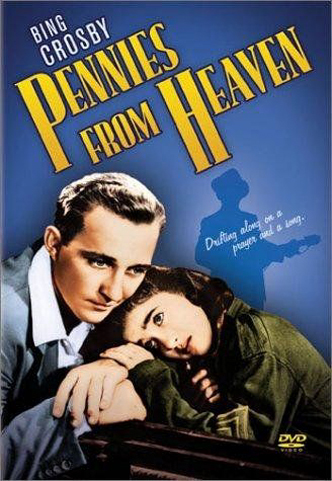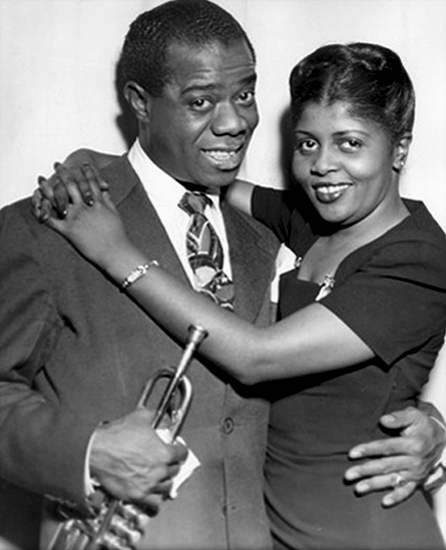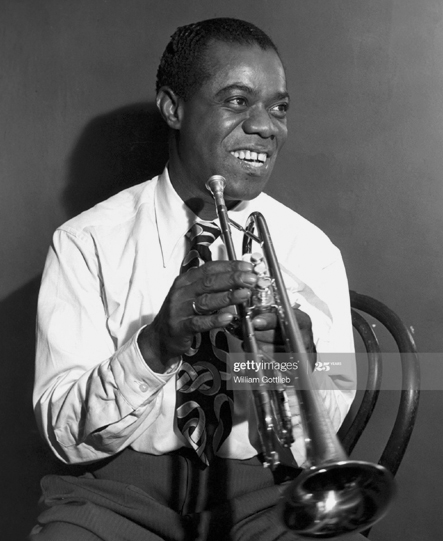Traditional jazz: “Public Melody Number One”, “When the Saints Go Marching In” (three versions) and “You Won’t Be Satisfied”
(Edited)
Public Melody Number One
Louis Armstrong and his Orchestra (1937).
The trumpet is a hard instrument on the lips and Louis Armstrong started to suffer from lip damage due to his aggressive way of playing, so he diversified, refined his way of singing and made his first theatrical appearances. In 1936 he premiered in Hollywood acting in the musical comedy movie Pennies from Heaven directed by Norman Z. McLeod co-starring Bing Crosby, and published the first autobiography of a jazz musician Swing That Music. In 1937 Armstrong took over Rudy Vallee’s Fleischmann’s Yeast Show on the CBS radio network for three months and became the first African-American to make a nationally sponsored broadcast. He also collaborated on radio programs like The Story of Swing (1937) and This Is Jazz (1947) and featured countless times on television, especially in the 1950s and 1960s.

Pennies from Heaven poster
Armstrong continued to record for Decca, resulting in the Top Ten hits “Public Melody Number One” (1937), “When the Saints Go Marching In” (1939) and “You Won’t Be Satisfied (Until You Break My Heart)” (1946) in duet with Ella Fitzgerald. Please, find the three of them below. In 1938 he divorced Lillian Hardin after seven years of separation. In 1939 he went back to Broadway in the short-lived musical Swingin’ the Dream, a jazz version of William Shakespeare’s A Midsummer Night’s Dream.

Decca Records logo
During the 1930s Armstrong developed fully his bubbling, magical personality and greatly improved his technique by playing abundant and elaborated solos in which he displayed his mastery, especially swinging in the upper-register of the trumpet and hitting high notes. The big bands of the swing era used new styles of written arrangements incorporating the riffs, across-the-bar phrasing and rhythmic innovations pioneered by Armstrong. By the end of the decade he was established as a major jazz singer, trumpeter and bandleader international star. In 1943 his manager Joe Glaser broke off his business relationship with the Luis Russell Orchestra and assembled a new big band for Armstrong, who settled permanently in Queens, New York, with his fourth wife Lucille Wilson, a Cotton Club dancer, with whom he remained for the rest of his life.

Louis Armstrong with his fourth and last wife Lucille Wilson



Louis Armstrong

When the Saints Go Marching In (original version)
Louis Armstrong and his Orchestra (1939).

When The Saints Go Marching In (in a movie)
Danny Kaye & Louis Armstrong from the movie The Five Pennies (1959).

You Won’t Be Satisfied (Until You Break My Heart)
Ella Fitgerald and Louis Armstrong with Bob Haggart’s Orchestra (1946).
0
0
0.000

Your post has been voted as a part of Encouragement program. Keep up the good work!
Try https://ecency.com and Earn Points in every action (being online, posting, commenting, reblog, vote and more).
Boost your earnings, double reward, double fun! 😉
Support Ecency, in our mission:
Ecency: https://ecency.com/proposals/141
Hivesigner: Vote for Proposal
You included some super recording of mister Armstrong. Love Ella, hence appreciate it so much you've included the last clip: Two super voices working together results in magic; Music that never ever will die; Not in my book at least :)
I'm glad you like it!
🎶😉